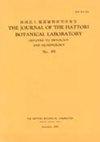The genus Arthrorhaphis in the Himalayas,the Karakorum and the subalpine and alpine regions of south-eastern Tibet
引用次数: 1
Abstract
The yellow coloured taxa of the genus Arthrorhaphis (i.e. A. alpina var. alpina, A. alpina var. jungens, A. citrinella and A. vaci/lans) have been revised for the Himalaya Range, the Karakorum and for the south-east Tibetan fringe-mountains. Arthrorhaphis alpina var.jungens, usually growing on sandy soi!, appears to be a rather abundant lichen on open alpine (Kobresia) meadows, often associated with other weakly calciphilous crusts, such as Megaspora verrucosa, Phaeorrhiza nimbosa, Ph. sareptana, Psora decipiens and several Toninia species. Arthrorhaphis vacil/ans, with generally similar ecological requirements, and A. alpina var. alpina in more sheltered localities, are less frequent. Arthrorhaphis citrinel/a, growing on mosses or decaying plants rather than over pure soi!, is much more scarce in the study area than in the European喜马拉雅山脉、喀喇昆仑和西藏东南部的亚高山和高山地区的赤藓属
在喜马拉雅山脉、喀喇昆仑和西藏东南部的边缘山区,对黄毛藓属(即A. alpina var. alpina、A. alpina var. jungens、A. citrinella和A. vaci/lans)的黄色分类群进行了修订。青豆,通常生长在沙质土壤上。在开放的高山草甸(Kobresia)上似乎是一种相当丰富的地衣,通常与其他弱亲钙结壳(如Megaspora verrucosa, Phaeorrhiza nimbosa, Ph. sareptana, Psora decipiens和一些Toninia种)相关。与一般生态需求相似的白骨关节炎(Arthrorhaphis vacil/ans)和在更隐蔽的地方出现的A. alpina var. alpina较少。柠檬酸盐,生长在苔藓或腐烂的植物上,而不是在纯净的土壤上!与欧洲相比,美国在研究地区的数量要少得多
本文章由计算机程序翻译,如有差异,请以英文原文为准。
求助全文
约1分钟内获得全文
求助全文

 求助内容:
求助内容: 应助结果提醒方式:
应助结果提醒方式:


